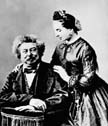|

|
|

|
.
|
Culture, history,
language, travel,
and more!
|
|
|
ALEXANDRE DUMAS père - French
Dramatist
|

The lasting fame of French writer Alexandre
Dumas {due-mah'}, known as Dumas père, b. July 24, 1802, d. Dec. 5, 1870, is
assured by such historical novels as The Three Musketeers and The Count of Monte
Cristo. Paradoxically, he exerted his greatest influence on literature through his early
plays, key works in the definition of French romanticism.
 By human, if not artistic, criteria, his prodigious output, the sheer energy of his writing,
and the hyperbolic force of his personality were matched only by such contemporary giants as
Honoré de Balzac and
Victor Hugo.
By human, if not artistic, criteria, his prodigious output, the sheer energy of his writing,
and the hyperbolic force of his personality were matched only by such contemporary giants as
Honoré de Balzac and
Victor Hugo.
Dumas's youth reflects the turbulence of the
early 19th century. His father, a general fallen out of favor with Napoleon, left the family
in financial difficulty at his death in 1806. Young Dumas's education was rudimentary. He
began clerking in 1818 and eventually worked for the duke of Orleans, who later became King
Louis Philippe.
During the 1820s, Dumas, like so many budding
romantics, fell under the spell cast by the plays of Shakespeare and the novels of Sir Walter
Scott. The influence of these English language models of theatricality and historical evocation
can be seen in the melodramatic situations of Henri III et sa cour (Henry III and His
Court, 1829), the first truly romantic melodrama produced by the Comédie Française.
For Antony (1831; Eng. trans., 1880), the dramatist found that a contemporary setting and
situation could also serve romanticism. Dumas's literary strengths were expressed flamboyantly
in dramatic conflicts, sudden reversals, and coincidences so thrilling that the audience had no
time to examine the plot's logic. His ability to create suspense is exemplified in La Tour
de Nesle (1832; Eng. trans., 1846).
With the publication of The Three Musketeers
(1844; Eng. trans., 1846) Dumas embarked on a novel cycle that covered nearly 50 years of French
history in the 17th century. This cycle included Twenty Years After (1845; Eng. trans.,
1846) and the story "The Man in the Iron Mask" from Le Vicomte de Bragelonne (1848-50;
Eng. trans., 1851). The Count of Monte Cristo (1844-45; Eng. trans., 1846) dealt with the
Napoleonic period. The Valois novels (1845-48) explored the 16th century. Dumas's extravagant
tastes forced him to maintain a hectic writing pace. His frequent use of collaborators (chiefly
Auguste Maquet) inspired controversy as to the extent of Dumas's authorship, but recent scholarship
has authenticated his contributions. If his boast of having written 1,200 volumes is a gross
exaggeration, an edition of his complete works containing 301 volumes (published and edited by
Michel Levy, 1862-89) is irrefutable proof of his unflagging energy. That energy animated his
journalistic enterprises, his extensive travels, and his adventures, including participation in
Garibaldi's campaign in Sicily in 1860. Scandals and financial vicissitudes plagued his last years.
He died in the home of his illegitimate son, the playwright and novelist
Alexandre Dumas.
The historical novels, upon which much of Dumas's
reputation rests, profited from the precedents set by Scott,
Balzac, and Hugo. Dumas was particularly adept at the
development of plot against a sharply etched, picturesque background. Despite their length,
the novels speed along at breakneck pace, and generations of readers have been enmeshed in
the unfolding narratives. Both the novels and plays, so appealing as popular literature, have
also won critical esteem for their inventiveness, an element characteristic of romantic art.
Charles Affron, Professor of French, New York University, New York City.
Source: 1997 Grolier Multimedia Encyclopedia v.9.0.1
Bibliography: A. Craig Bell, Alexander Dumas (1950; repr. 1973);
Francis Gribble, Dumas: Father and Son (1930; repr. 1973);
F.W. Hemmings, Alexandre Dumas (1980);
André Maurois, The Titans: A Three Generation Biography of the Dumas,
trans. by Gerard Hopkins (1957; repr. 1971);
A.E. Murch, ed., Alexandre Dumas' Adventures in Czarist Russia (1961; repr. 1975);
C. Schopp, Alexandre Dumas (1988);
Richard S. Stowe, Alexandre Dumas Père (1976).
Image Source: portrait of Alexandre Dumas
with his daughter Marie - The Bettmann Archive.
|
Playwright Biographies:
|

|
|
|
Dumas père Links:
|

|
|
-
(links under construction)
|
|
|
SUGGEST A SITE
Do you know of a great Alexandre Dumas père site we should list
here? Please submit it!
|
|

|
Design and layout
©
1997-2000
|
All Rights Reserved
|
Comments, suggestions,
broken links?
|

|
Produced by
The Wharton Group
and
Ian C. Mills
|

Please notify us!
|
The Y29K
- compliant computer
preferred by designers everywhere.
|
|
This site
recycled
|

|
uses
electrons.
|
|
visitors
|
 Text and image copyrights are attributed to their
respective sources throughout this site.
Text and image copyrights are attributed to their
respective sources throughout this site.
|
|

 By human, if not artistic, criteria, his prodigious output, the sheer energy of his writing,
and the hyperbolic force of his personality were matched only by such contemporary giants as
Honoré de Balzac and
Victor Hugo.
By human, if not artistic, criteria, his prodigious output, the sheer energy of his writing,
and the hyperbolic force of his personality were matched only by such contemporary giants as
Honoré de Balzac and
Victor Hugo.